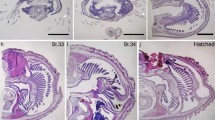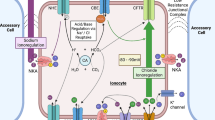Summary
There are species of hydrozoans, Eutonina victoria, Mitrocomella polydiademata, and Phialidium gregarium whose eggs contain calcium-specific photoproteins. These cytoplasmic photoproteins are synthesized during oogenesis. During the cleavage stages of embryogenesis they are distributed to all of the cells of the developing planula larva. The amount of photoprotein slowly declines during the development of the planula larva, and markedly declines when the planula undergoes metamorphosis to become a polyp.
Oocytes, unfertilized eggs, and fertilized eggs prior to the first cleavage do not produce light when treated with KCl. The ability to respond to KCl appears about the time of first cleavage, and is correlated with the appearance of active membrane responses. Both the KCl response and the action potentials will occur in sodium-free sea water, and both are inhibited by calcium channel blockers. These and other experiments suggest that voltage sensitive calcium channels first become active at about the time of first cleavage. These channels also appear on the same schedule in both unfertilized eggs and in enucleated egg fragments, which have been artificially activated with A23187.
Developing planulae produce few or no spontaneous light responses before gastrulation. Later the frequency and magnitude of spontaneous light production increases presumably due to an increasing frequency and magnitude of calcium transients. Both the natural trigger of metamorphosis (bacteria) and an artificial trigger (CsCl) cause a conspicuous series of calcium transients. When these transients are inhibited by calcium channel blockers, metamorphosis is also inhibited.
Similar content being viewed by others
References
Arai MN, Brinkmann-Voss A (1980) Hydromedusae of British Columbia and Puget Sound. Can Bull Fisheries Aquatic Sci 204:1–192
Ballard WW (1942) The mechanism for synchronous spawning in Hydractinia and Pennaria. Biol Bull 82:329–339
Berking S (1984) Metamorphosis of Hydractinia echinata: Insights into pattern formation in Hydroids. Wilhelm Roux's Arch 193:370–378
Blinks JR, Prendergast FG, Allen DG (1976) Photoproteins as biological indicators. Pharmacol Rev 28:1–93
Bodo F, Bouillon J (1968) Étude histologique du developpement embryonnaire de quelques hydroméduses de Roscoff: Phialidium hemisphaericum (L), Obelia sp. (Peron et Lesueur), Sarsia eximia (Allman), Podocoryne carnea (Sars), Gonionemus veritans (Agassiz). Cah Biol Mar 9:69–104
Campbell AK (1974) Extraction, partial purification and properties of obelin the calcium-activated luminescent protein from the hydroid Obelia geniculata. Biochem J 143:411–418
Caplan AI, Fiszman MY, Eppenberger HM (1983) Molecular and cell isoforms during development. Science 221:921–927
Cavanaugh GM (1956) Formulae and methods IV of the marine biological laboratory chemical room, Woods Hole, pp 62–69
Davenport D, Nicol JAC (1955) Luminescence in hydromedusae. Proc R Soc [Ser B] 144:399–411
Devlin RB, Emerson CP Jr (1978) Coordinate regulation of contractile protein synthesis during myoblast differentiation. Cell 13:599–611
Freeman G (1980) The role of cleavage in the establishment of the anterior-posterior axis of the hydrozoan embryo. In: Tardent P, Tardent R (eds) Developmental and cellular biology of coelenterates. Elsevier/North Holland, pp 96–108
Freeman G (1983) Experimental studies on embryogenesis in hydrozoans (Trachylina, Siphonophora) with direct development. Bio Bull 165:591–618
Freeman G, Miller R (1982) Hydrozoan eggs can only be fertilized at the site of polar body formation. Dev Biol 94:142–152
Freeman G, Ridgway E (1983) Bioluminescence during development in the hydrozoan, Phialidium. Am Zool 24:1014
Hagiwara S (1983) Membrane potential dependent ion channels in cell membrane. Raven Press, New York
Hagiwara S, Yoshida S, Yoshii M (1981) Transient and delayed potassium currents in the egg cell membrane of the coelenterate, Renilla koellikeri. J Physiol (Lond) 318:123–141
Harvey EN (1921) Studies on bioluminescence XIII. Luminescence in the coelenterates. Biol Bull 41:280–287
Hastings JW (1983) Biological diversity, chemical mechanisms and the revolutionary origins of bioluminescent systems. J Mol Evol 19:309–321
Hodgkin AL, Horowicz P (1960) Potassium contractures in single muscle fibers. J Physiol 153:386–403
Levine LD, Ward WW (1982) Isolation and characterization of a photoprotein, “phialidin” and a spectrally unique green-fluorescent protein from the bioluminescent jellyfish Phialidium gregarium. Comp Biochem Physiol 72B:77–85
Loyd JE, Raff EC, Raff RA (1981) Site and timing of synthesis of tubulin and other proteins during oogenesis in Drosophila melanogaster. Dev Biol 86:272–284
Mabuchi I, Spudich JA (1980) Purification and properties of soluble actin from sea urchin eggs. J Biochem (Tokyo) 87:785–802
Martin V, Chia F, Koss R (1983) A fine structural study of metamorphosis of the hydrozoan Mitrocomella polydiademata. J Morphol 176:261–287
Miller RL (1978) Site-specific sperm agglutination and the timed release of a sperm chemoattractant by the egg of the leptomedusan Orthopyxis caliculata. J Exp Zool 205:385–392
Miller RL (1979) Sperm chemotaxis in the hydromedusae I. Species-specificity and sperm behavior. Mar Biol 53:99–114
Moreau M, Guerrier P, Doree M, Ashley CC (1978) 1-adenine methyl induces release of intracellular calcium and triggers meiosis in starfish oocytes. Nature (Lond) 272:251–253
Morin JG (1974) Coelenterate bioluminescence. In: Muscatine L, Lenhoff H (eds) Coelenterate biology: reviews and new perspectives. Academic Press, New York, pp 397–438
Müller W (1973) Metamorphose-Induction bei Planulalarven. I. Der bakterielle Inductor. Wilhelm Roux's Arch 173:107–121
Müller W, Buchel G (1973) Metamorphose-Induction bei Planulalarven. II. Induction durch monovalente Kationen. Wilhelm Roux's Arch 173:122–135
Müller W, Mitze A, Wickhorst J, Meir-Menge H (1977) Polar morphogenesis in early hydroid development: action of caesium, of neurotransmitters and of an intrinsic head activator on pattern formation. Wilhelm Roux's Arch 182:311–328
Pestell RQW (1975) Microtubule protein synthesis during oogenesis and early embryogenesis in Xenopus laevis. Biochem J 145:527–534
Ridgway EB, Freeman G (1984) Calcium mediated light emission from eggs and embryos of the hydromedusan Phialidum. Biophys J 45:180A
Ridgway EB, Freeman G (1985) Endogenous calcium indicator reveals development of calcium channels in hydromedusan embryos. Biophys J 47:264A
Ridgway EB, Gilkey JC, Jaffe LF (1977) Free calcium increases explosively in activating medaka eggs. Proc Natl Acad Sci (USA) 74:623–628
Saki M, Shinagawa A (1983) Cyclic-cytoplasmic activity of nonnucleated egg fragments of Xenopus controls the morphology of injected sperms. J Cell Sci 63:69–76
Satterlie R, Case J (1979) Development of bioluminescence and other effector responses in the pennatulid coelenterate Renilla köllikeri. Bio Bull 157:506–523
Shimomura O (1986) Isolation and properties of various molecular forms of aequorin. Biochem J 234:271–277
Shimomura O, Johnson FH, Saiga Y (1962) Extraction, purification and properties of aequorin, a bioluminescent protein from the luminous hydromedusan Aequorea. J Cell Comp Physiol 59:223–240
Shimomura O, Johnson FH, Saiga Y (1963) Extraction and properties of halistaurin, a bioluminescent protein from the hydromedusan Halistaura. J Cell Comp Physiol 62:9–16
Shimomura O, Shimomura A (1985) Halistaurin, phialidin and modified forms of aequorin as Ca2+ indicator in biological systems. Biochem J 228:745–749
Spindler K, Müller W (1972) Induction of metamorphosis by bacteria and by a lithium-pulse in the larvae of Hydractinia echinata (Hydrozoa). Wilhelm Roux's Arch 169:271–280
Winkler MM, Steinhardt RA, Grainger JL, Minning L (1981) Dual ionic controls for the activation of protein synthesis at fertilization. Nature (Lond) 287:558–560
Yoneda M, Ikeda M, Washitami S (1978) Periodic changes in the tension on the surface of activated non-nucleated fragments of sea urchin eggs. Dev Growth Differ 20:329–336
Author information
Authors and Affiliations
Rights and permissions
About this article
Cite this article
Freeman, G., Ridgway, E.B. Endogenous photoproteins, calcium channels and calcium transients during metamorphosis in hydrozoans. Roux's Arch Dev Biol 196, 30–50 (1987). https://doi.org/10.1007/BF00376020
Received:
Accepted:
Issue Date:
DOI: https://doi.org/10.1007/BF00376020




